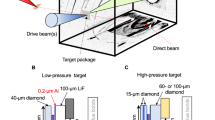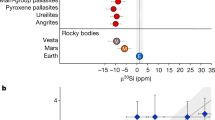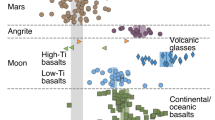Abstract
Primitive meteorites contain several noble gas components with anomalous isotopic compositions which imply that they—and their solid 'carrier' phases—are of exotic, pre-solar origin. Having enriched two of these gas components by a factor of ∼2× 104 in minor fractions of the Murray meteorite1, we found that these fractions contain two minerals not previously seen in meteorites: silicon carbide and an amorphous Si–O phase2, possibly an alteration product of another silicon-bearing mineral. Here we report ion microprobe analyses of these phases which reveal very large isotopic anomalies in silicon, nitrogen and carbon, exceeding the highest anomalies previously measured by factors of up to ˜50. We conclude that these phases are circumstellar grains from carbon-rich stars, whose chemical inertness allowed them to survive in exceptionally well-preserved form.
This is a preview of subscription content, access via your institution
Access options
Subscribe to this journal
Receive 51 print issues and online access
$199.00 per year
only $3.90 per issue
Buy this article
- Purchase on Springer Link
- Instant access to full article PDF
Prices may be subject to local taxes which are calculated during checkout
Similar content being viewed by others
References
1. Tang, M. & Anders, E. Geochim. cosmochim. Acta (submitted). 2. Bernatowicz, T. et al. Nature 330, 728-730 (1987). 3. Lewis, R. S., Tang, M., Wacker, J. F., Anders, E. & Steel, E. Nature 326, 160-162 (1987). 4. Lewis, R. S., Bright, D. & Steel, E. Meteoritics 22 (in the press). 5. McKeegan, K. D., Walker, R. M. & Zinner, E. Geochim. cosmochim. Acta 49, 1971-1987 (1985). 6. Zinner, E. & Epstein, S. Earth planet. Sci. Lett. 84, 359-367 (1987). 7. Clayton, R. N., Mayeda, T. K. & Molini-Velsko, C. A. in Protostars and Planets II (eds Black, D. C. & Matthews, M. S.) 755-771 (University of Arizona Press, Tucson, 1985). 8. Lattimer, J. M., Schramm, D. N. & Grossman, L. Astrophys. J. 219, 230-249 (1978). 9. Swart, P. K., Grady, M. M., Pillinger, C. T., Lewis, R. S. & Anders, E. Science 220, 406-410 (1983). 10. Ash, R. D. et al. Meteoritics 22 (in the press). 11. Clayton, D. D. & Hoyle, F. Astrophys. J. 203, 490-496 (1976). 12. Yang, J. & Epstein, S. Nature 311, 544-547 (1984). 13. Pillinger, C. T. Eur. Space Ag. spec. Publ. SP-249, 41-45 (1986). 14. Oilman, R. C. Astrophys. J. 155, L185-L187 (1969). 15. Larimer, J. W. & Bartholomay, M. Geochim. cosmochim. Acta 43, 1455-1466 (1979). 16. Kleinmann, S. G., Gillett, F. C. & Joyce, R. R. A. Rev. Astr. Astrophys. 19, 411 (1981). 17. Arnett, D. Nature (submitted). 18. Tang, M. & Anders, E. Geochim. cosmochim. Acta (submitted). 19. Salpeter, E. E. A. Rev. Astr. Astrophys. 15, 267-293 (1977). 20. Schramm, D. N. & Olive, K. A. Ann. N.Y. Acad. Sci. 395, 236-241 (1982).
Author information
Authors and Affiliations
Rights and permissions
About this article
Cite this article
Zinner, E., Ming, T. & Anders, E. Large isotopic anomalies of Si, C, N and noble gases in interstellar silicon carbide from the Murray meteorite. Nature 330, 730–732 (1987). https://doi.org/10.1038/330730a0
Received:
Accepted:
Issue Date:
DOI: https://doi.org/10.1038/330730a0
This article is cited by
-
The NC-CC Isotope Dichotomy: Implications for the Chemical and Isotopic Evolution of the Early Solar System
Space Science Reviews (2020)
-
On laboratory studies of grains from outside the solar system
Journal of Earth System Science (1998)
-
Interstellar grains in meteorites
Nature (1993)
-
Stardust memories
Nature (1992)
Comments
By submitting a comment you agree to abide by our Terms and Community Guidelines. If you find something abusive or that does not comply with our terms or guidelines please flag it as inappropriate.



